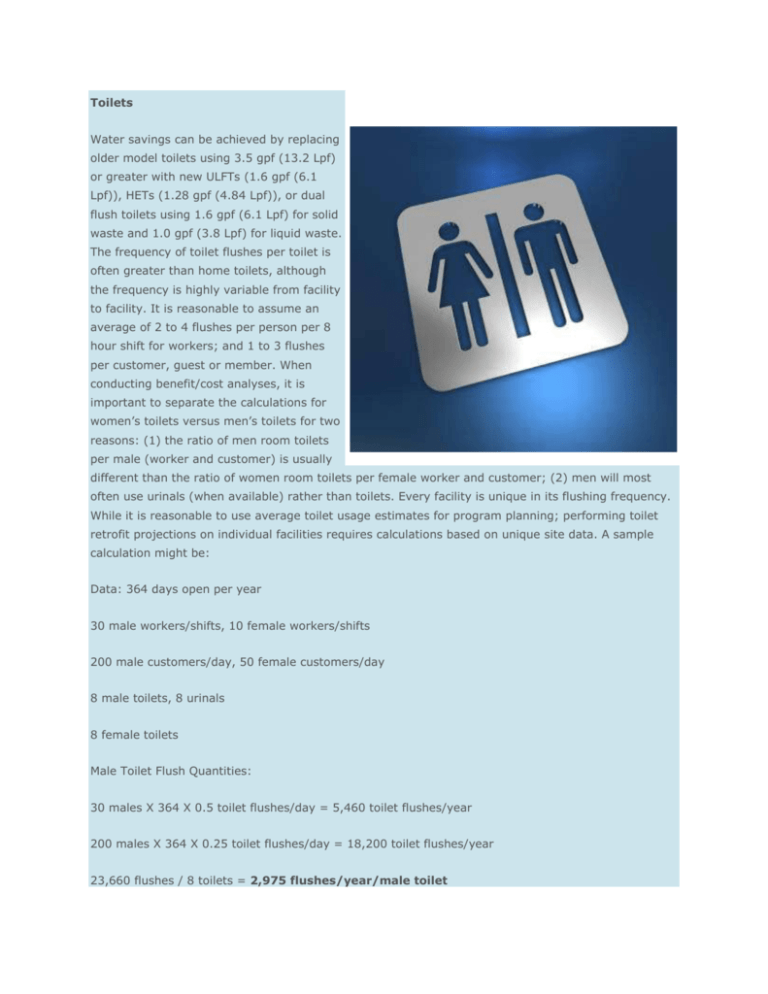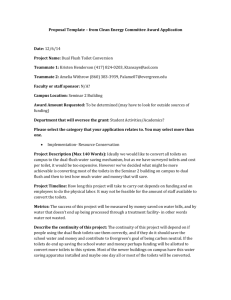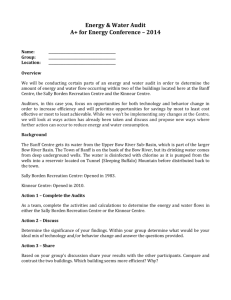AWE CII Restroom fix..
advertisement

Toilets Water savings can be achieved by replacing older model toilets using 3.5 gpf (13.2 Lpf) or greater with new ULFTs (1.6 gpf (6.1 Lpf)), HETs (1.28 gpf (4.84 Lpf)), or dual flush toilets using 1.6 gpf (6.1 Lpf) for solid waste and 1.0 gpf (3.8 Lpf) for liquid waste. The frequency of toilet flushes per toilet is often greater than home toilets, although the frequency is highly variable from facility to facility. It is reasonable to assume an average of 2 to 4 flushes per person per 8 hour shift for workers; and 1 to 3 flushes per customer, guest or member. When conducting benefit/cost analyses, it is important to separate the calculations for women’s toilets versus men’s toilets for two reasons: (1) the ratio of men room toilets per male (worker and customer) is usually different than the ratio of women room toilets per female worker and customer; (2) men will most often use urinals (when available) rather than toilets. Every facility is unique in its flushing frequency. While it is reasonable to use average toilet usage estimates for program planning; performing toilet retrofit projections on individual facilities requires calculations based on unique site data. A sample calculation might be: Data: 364 days open per year 30 male workers/shifts, 10 female workers/shifts 200 male customers/day, 50 female customers/day 8 male toilets, 8 urinals 8 female toilets Male Toilet Flush Quantities: 30 males X 364 X 0.5 toilet flushes/day = 5,460 toilet flushes/year 200 males X 364 X 0.25 toilet flushes/day = 18,200 toilet flushes/year 23,660 flushes / 8 toilets = 2,975 flushes/year/male toilet Male Urinal Flush Quantities: 30 males X 364 X 2.5 urinal flushes/day = 27,300 urinal flushes/year 200 males X 364 X 1.75 urinal flushes/day = 127,400 urinal flushes/year 154,700 flushes / 8 urinals = 19,300 urinal flushes/year/urinal Female Toilet Flush Quantities: 10 females X 364 X 3 toilet flushes/day = 10,920 toilet flushes/year 50 females X 364 X 2 toilet flushes/day = 36,400 toilet flushes/year 47,320 flushes / 8 toilets = 5,915 flushes/year/female toilet Conclusion: This example shows replacing male urinals will likely garner the greatest savings; and replacing female toilets offers better return on investment than male toilets. The predominate types of toilets in CII restrooms are the flushometer valve toilet or the pressure-assist toilet, though gravity-tank toilets are found occasionally. Both the bowl and the flush valve of the flushometer valve toilets must be replaced to assure water savings and adequate flushing performance. The cost to replace a flushometer type toilet usually ranges from $250 to $400, depending on the type of toilet required. Wall-mounted flushometer valve toilets are the most commonly found in new buildings; while floor mounted toilets are more common in older buildings. As with all toilets in the commercial sector, there are a few extras items to consider: Building maintenance staff must be trained to only use the proper parts when servicing the flush valves, or all water savings will be negated. Unfortunately, 3.5 gpf (13.2 Lpf) parts often fit the new 1.6 gpf (6.1 Lpf) flush valves. Replacement options include the 1.6 gpf (6.1 Lpf) toilets, and there are now hundreds of models of HETs available (1.28 gpf (4.84 Lpf)models and dual flush) While there are many gravity type toilets suitable for light commercial applications, flushometer valve types or pressure-assist models are preferable in most commercial buildings. Sensor-activated flush mechanisms often result in more frequent toilet flushing than manual flush valves. There is no evidence the sensor-activated valves save water. If installing dual-flush toilets, it is wise to post instructions for the toilet users. Disposable seat covers and paper towels are the most common causes of clogged toilets. Consider alternate methods of hygiene (sanitizers, continuous roll seat cover dispensers, hot air dryers, etc.), or select new toilets models that exceed 500 grams (1.1 pounds) in MaP Testing. Flushing performance is very important for success. Refer the MaP testing before selecting new toilets. Urinals The benefit of replacing urinals is highly dependant on frequency of use and the type of replacement proposed. Frequency of use is determined by calculating the quantity of male 8-hour shifts, the average urinal flush per man per 8-hour shift (usually 2 to 4), and the quantity of urinals. Depending on the nature of the CII facility, visitors may add significantly to the daily flush counts. There are many options now for urinal replacements; from simply replacing the flush valve to reduced flows, to replacing the entire fixture with a high-efficiency urinal (HEU), which includes both flushing and non-water urinals. All options vary in the costs and benefits. In many cases, marginal water savings can be achieved by simply retrofitting the urinal flush valve to a lower gpf diaphragm on flushometer valve urinals, though some older urinals will not properly function at these reduced flows. Unfortunately, this type of valveonly retrofit can be easily and mistakenly reverted back to the higher flush volume during routine maintenance; thus, we seldom recommend this “partial” measure. Much consideration is needed to determine the best retrofit or replacement for any given restroom. To assure water savings are sustained over time, the best strategy is to replace the entire urinal and flush valve with an HEU (e.g., 0.125 gpf or 0.25 gpf (.47 Lpf or .94 Lpf) model, or a non-water urinal). As with all urinals in the non-residential sector, there are a few extras items to consider: Building maintenance staff must be trained to only use the proper parts when servicing the flush valves or all water savings will be negated. Unfortunately, 3.5 gpf (13.2 Lpf) parts often fit the new 1.0 gpf (3.78 Lpf) flush valves. Sensor-activated flush mechanisms often result in more frequent urinal flushing than manual flush valves. There is no evidence the sensors valves save water. Non-water urinals are considered compliant by most, but not all plumbing code authorities. The Uniform Plumbing Code and the International Plumbing code allow the urinals, but some local cities and counties have not yet approved the devices. It is wise to contact the local plumbing jurisdiction before installing non-water urinals. Lavatory Faucets Flow rates for wash basin faucets in lavatories can reasonably be reduced to 0.5 gpm (1.89 Lpm) or lower. (The current national standard and all of the major model plumbing codes in the U.S. call for a maximum flow rate in non-residential lavatory faucet installations of 0.5-gpm (1.9-Lpm.) Projected savings are usually based on usage frequencies similar to toilet and urinal use. Flow durations are often estimated to be 5 to 30 seconds per use. Retrofitting aerators on the faucets is the most common and least expensive strategy. The water savings are small when compared to replacing toilets, but the cost of retrofit is minor, usually less than $1.00 per faucet. Some wash basins are fitted with mechanical metering valves (automatically shut-off after a preset time span) or negative shut-off valves (user must continue to exert pressure on valve handle to maintain water flow). These types of valves are required to save water and deter flooding the lavatories. The valves are often adjustable for the duration of the flow. The flow should not exceed 5 seconds per activation. There is no scientific evidence that sensor-activated faucets save water. To the contrary, recent studies have provided valid evidence that sensor faucets use much greater water than manually activated valves. Sensor activated valves provide user convenience, but are now known to be wasters of water. Showers Some CII facilities include showers. The Energy Policy Act of 1995 set maximum showerhead flow rates rate at 2.5 gallons per minute (gpm) (9.5 Lpm). Despite this federal mandate, some showers flows can still be found flowing in excess of 5 GPM (18.9 Lpm). Depending on frequency of use, replacing showerheads in the locker rooms might offer significant water savings. New, well-designed 2.5 gpm (9.5 Lpm) showerheads offer a satisfying and effective shower experience for users. There are some models of showerheads that flow less than 2.5 gpm (9.5 Lpm) and also have high levels of consumer satisfaction, but these are not recommended for safety concerns. As showerhead flow rates have decreased, the incidents of accidental scalding have increased; caused by the loss of thermal buffering in water volume when supply water temperature changes suddenly. Thermostatic mixing valves prevent this problem, and are now required by most plumbing codes. To date, thermostatic mixing valves are only tested and certified for flows of 2.5 gpm (9.5 Lpm) or greater. Installing showerheads with flow rates below 2.5 gpm (9.5 Lpm) is not recommended until thermostatic mixing valve requirements are amended to accommodate lower flows. Water savings projections can be easily estimated by measuring the flow rates of the pre-existing showerheads, estimating the usage rate, and calculating the water use differential. A facility that has 20 showers taken per day, using 4 gpm showerheads, could save 9,000 gallons per month (34 m3) by converting to 2.5 gpm (9.5 Lpm) showerheads. This equates to more than 100,000 gallons saved per year (378.5 m3). Building managers are very sensitive to user satisfaction, especially private membership clubs, and shower quality seems to evoke strong reactions. It is very important to choose replacement showerheads that are known to have a high level of user satisfaction. Most high quality showerheads cost $5 to $12 in bulk quantities. We do not recommend using price as sole criteria when selecting showerheads.






